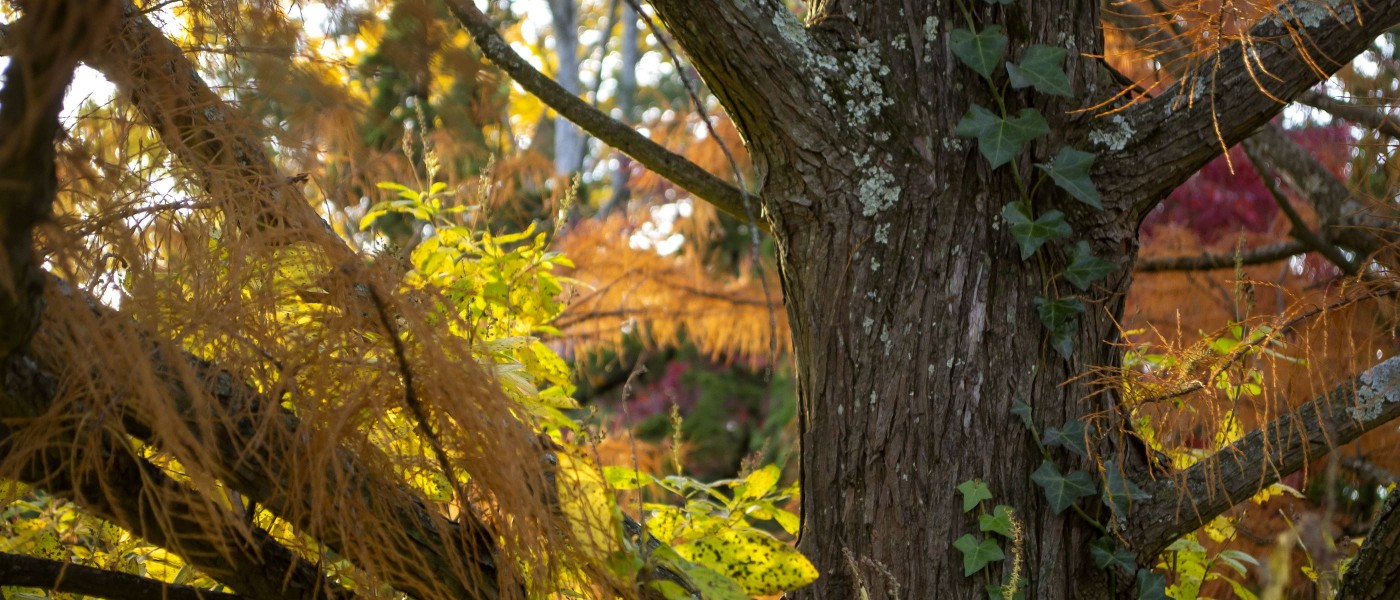Kamala Sankaram Asks What We Mean By “Nature”
For the past few months, artist in residence Kamala Sankaram has been exploring the grounds of Brooklyn Botanic Garden and soaking in the stories of its trees.
Sankaram is an award-winning composer and musician whose wide-ranging work shifts from contemporary opera to electronic music, often incorporating emerging technologies. On September 30 and October 1, Sankaram presents two new pieces inspired by the Garden’s 2023 theme, Power of Trees.
We spoke with Sankaram about the unexpected trees that captured her imagination, the blurry borders that define the “natural” world, and learning to pay attention.
What has your experience been like at the Garden?
I came in with this idea that I was going to make something that would be related to the Power of Trees, but that the project would be determined by what happened while I was in the Garden.
And what that has meant is just walking around a lot and letting the landscape decide what I looked at. As I’m walking along, what am I drawn to? And then bringing that to the people that work at the Garden and asking them lots of questions—what is this tree? What is special about this tree? Why am I attracted to this tree?
It’s taken this tangent that I didn’t expect. My own assumptions were immediately challenged during conversations with [director of Horticulture] Shauna Moore and [vice president of Horticulture] Rowan Blaik. Most of the trees that I found myself drawn toward are actually cultivars—forms that are not exactly found in nature, but are specifically cultivated for their likable traits.
It led me down this path of thinking more deeply not just about the trees, but about how we relate to the trees. Talking with some of the Garden’s Power of Trees consultants has raised a lot of very big questions, like, where do we draw the borders around what is natural and what is not?
Being given access to not just the Garden but the people who work in and with the Garden has allowed me to think more deeply about this relationship between people and the natural world, and how we think of ourselves as separate from that nature, but we aren’t. We are constantly interacting with and influencing it, and it is influencing us, and we are part of it.
What can you tell us about the pieces you’re creating?
I’m writing two multipart musical works. One is for the group The Western Wind, an a capella vocal ensemble. Their piece is more focused on these specific trees, which include the magnolia ‘Evamaria’, the weeping beech, the dawn redwoods, and the cherry trees, of course. It’s not just about the trees themselves, but also how we relate to them.
The other new work that I’m creating is going to be performed with electronics. There will be field recordings that include the voices of people from the Garden that I talked to, and some of the community field recordings that I solicited may also make it in.
This piece engages more with a philosophy of nature, and what does “nature” even mean?
For many of us, when we say “nature,” we mean this untouched environment. And the truth is that that doesn’t really exist, especially now. I think part of the difficulty around climate change, in particular, is accepting that it’s not separate from us, it is us, right? Whatever we do to the environment we are doing to ourselves.
How can music help to build that sense of empathy and interconnectedness?
Music affects us on a visceral level, even down to a physiological response.
There are studies that record what’s called the “chill response” to music. If you put a monitor on someone who’s listening to a piece of music, they get chills when it affects them. It actually makes their hair stand up a little bit. So it has a physical impact on you that can lead to an emotional state that then can be shared among many people at the same time. And that’s empathy.
But it also requires you, if you’re really listening, to be in an attentive state for a duration of time—and that is something that we are very bad at, especially right now. Often music is just something in the background, but I’m referring to active listening, in a concert setting or wherever you might be. Music can draw a line around something and say, point your attention at this for a little bit.
I think one of the goals in doing this kind of work is to encourage people to notice things more, and particularly, to listen more. And this is what spaces like the Botanic Garden do—they provide a place for repose, but also give us a frame for deeper engagement with the plants and diverse ecosystems around us.
I hope that after the performance, during the walk through the Garden back to the entrance, you’ll stay in that frame a little longer, allowing yourself to notice things that you may not have noticed when you came in.


